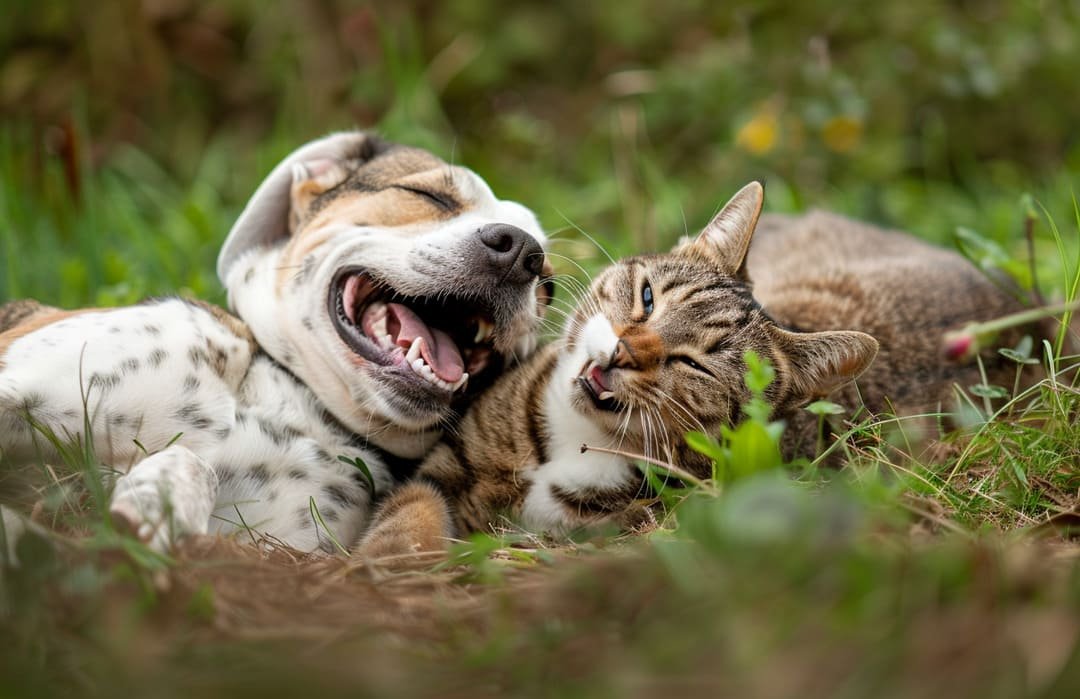Training a stubborn cat can be a challenging yet rewarding endeavor for any cat owner. From unraveling the mystery behind your feline companion's behaviors to mastering effective training techniques, the journey to understanding how to train a stubborn cat is a path filled with patience, perseverance, and a deep bond between you and your pet. As you venture into the world of feline training, let's explore innovative strategies, expert insights, and practical tips to transform your stubborn cat into a well-behaved and responsive companion.
Setting the Stage for Successful Training
Creating a Positive Training Environment
When embarking on the journey to train a stubborn cat, setting up a positive training environment is crucial. Here are some key elements to consider:
-
Quiet Space: Choose a quiet area in your home where distractions are minimal. Cats are sensitive to their surroundings, so creating a peaceful training space can help them focus better.
-
Comfortable Setup: Ensure your cat has a comfortable space to relax during training sessions. Providing a cozy bed or blanket can make the training experience more pleasant for your feline friend.
-
Natural Lighting: Natural light can positively impact your cat's mood and energy levels. If possible, conduct training sessions in a well-lit room to create a cheerful atmosphere.
-
Interactive Toys: Incorporate interactive toys into your training regimen to keep your cat engaged and motivated. Toys like feather wands or treat dispensers can add an element of fun to the training process.
By establishing a positive and comfortable training environment, you can set the stage for successful training sessions with your stubborn cat.
Using the Right Rewards and Reinforcements
Reward-based training is a highly effective method for training stubborn cats. Here are some tips on selecting the right rewards and reinforcements for your feline companion:
-
Tasty Treats: Use small, flavorful treats that your cat finds irresistible as rewards for good behavior. Opt for treats with a strong aroma or unique texture to capture your cat's attention.
-
Verbal Praise: Cats respond well to positive reinforcement in the form of verbal praise. Shower your cat with affectionate words and a gentle tone to reinforce desired behaviors.
-
Playtime Rewards: Incorporate playtime as a reward for your cat's cooperation during training. Interactive play sessions can strengthen your bond with your cat and serve as a fun incentive.
-
Consistent Reinforcements: Be consistent in rewarding your cat for displaying the desired behavior. Establish a clear association between the behavior and the reward to reinforce positive habits effectively.
By choosing the right rewards and reinforcements, you can motivate your stubborn cat to learn and engage in training activities effectively.
Techniques for Training a Stubborn Cat
Clicker Training for Cats
Clicker training is a popular and effective method for training stubborn cats. Here's how you can incorporate clicker training into your cat's training regimen:
-
Introducing the Clicker: Start by associating the clicking sound of the clicker with a tasty treat. Click the device and immediately reward your cat with a treat to create a positive connection.
-
Click and Reward: Use the clicker to mark desirable behaviors in your cat, such as sitting on command or using a scratching post. Each time your cat performs the behavior, click the device and offer a reward.
-
Consistent Repetition: Practice clicker training consistently to reinforce positive behaviors. Repetition helps your cat understand the correlation between the clicker sound and the reward, encouraging them to repeat the desired actions.
-
Gradual Progression: Gradually increase the complexity of commands or behaviors you teach your cat using the clicker. Start with simple tasks and build up to more advanced tricks as your cat becomes more proficient.
Clicker training can be a fun and interactive way to engage with your cat while encouraging them to learn new skills.
Target Training for Specific Behaviors
Target training is another useful technique for addressing specific behaviors in stubborn cats. Here's how you can implement target training with your feline companion:
-
Choosing a Target: Select a target object, such as a stick or a touch pad, for your cat to interact with during training. The target should be easy to distinguish and manipulate.
-
Positive Reinforcement: Encourage your cat to touch or interact with the target object by offering rewards for successful interactions. Use treats or praise to reinforce the behavior.
-
Shaping Behaviors: Shape your cat's behavior by guiding them to touch the target object with their nose or paw. Gradually increase the distance or complexity of the task to challenge your cat and promote learning.
-
Troubleshooting: If your cat is hesitant to engage with the target, break down the training process into smaller steps and offer plenty of rewards for incremental progress.
Target training can help improve your cat's focus, coordination, and responsiveness to commands, making it a valuable tool in training stubborn felines.
Addressing Specific Behavioral Issues
Curbing Aggression or Destructive Behavior
Dealing with aggression or destructive behavior in a stubborn cat can be challenging but manageable with the right approach. Here are some strategies to address these behavioral issues:
-
Identify Triggers: Determine the root cause of your cat's aggression or destructive behavior. Common triggers include stress, territorial disputes, or lack of stimulation.
-
Redirect Behavior: Redirect your cat's aggressive or destructive tendencies towards more appropriate outlets, such as scratching posts, interactive toys, or puzzle feeders.
-
Provide Enrichment: Enrich your cat's environment with mental and physical stimulation to prevent boredom and reduce the likelihood of destructive behavior. Consider rotating toys, introducing new play activities, or creating vertical spaces for climbing.
-
Consistent Discipline: Use positive reinforcement to encourage good behavior and discourage negative behaviors. Avoid punishment-based techniques, as they can exacerbate aggression or fear in cats.
By addressing the underlying causes of aggression or destructive behavior and implementing positive reinforcement strategies, you can help your stubborn cat develop healthier habits.
Encouraging Positive Social Interactions
If your stubborn cat displays antisocial behavior, it's essential to facilitate positive social interactions to improve their sociability. Here are some tips for encouraging positive socialization:
-
Slow Introductions: Introduce your cat to new people or animals gradually and in a controlled environment. Allow your cat to approach at their own pace and provide positive experiences during interactions.
-
Reward Social Behaviors: Reward your cat for calm, social behaviors such as approaching visitors, engaging in gentle play, or accepting gentle petting. Use treats or verbal praise to reinforce these positive interactions.
-
Building Confidence: Help build your cat's confidence by creating safe spaces where they can retreat when feeling overwhelmed. Provide hiding spots, elevated perches, and comfortable resting areas to promote a sense of security.
-
Professional Assistance: If your cat struggles with socialization despite your efforts, consider seeking guidance from a professional animal behaviorist or trainer. They can offer personalized strategies to address your cat's specific needs.
Encouraging positive social interactions can enhance your cat's quality of life and strengthen their bond with you and other members of your household.
Seeking Professional Help When Needed
Consulting with a Veterinarian or Animal Behaviorist
If you are facing challenges in training your stubborn cat or encountering concerning behaviors, seeking professional help from a veterinarian or animal behaviorist can provide valuable guidance. Here are reasons to consider professional assistance:
-
Behavioral Assessment: A veterinarian or animal behaviorist can conduct a thorough assessment of your cat's behavior to identify any underlying medical issues or behavioral concerns that may be contributing to their stubbornness.
-
Personalized Training Plans: Professionals can create customized training plans tailored to your cat's individual needs and temperament. These plans may include specialized techniques and strategies to address specific behavior problems effectively.
-
Medication Management: In some cases, medication may be recommended to manage behavioral issues or underlying medical conditions that could be impacting your cat's behavior. A professional can prescribe and monitor the appropriate medication regimen.
-
Ongoing Support: Veterinarians and behaviorists can provide ongoing support and guidance throughout the training process, offering insights, troubleshooting tips, and adjustments to the training plan as needed.
Seeking the expertise of professionals can enhance the effectiveness of your training efforts and improve the overall well-being of your stubborn cat.
Exploring Advanced Training Programs or Classes
For cat owners looking to take their training efforts to the next level, enrolling in advanced training programs or classes can offer additional support and resources. Here's why you might consider exploring advanced training options:
-
Specialized Expertise: Advanced training programs often provide access to specialized trainers with expertise in working with stubborn or behaviorally challenged cats. These professionals can offer advanced techniques and insights.
-
Structured Learning Environment: Training classes provide a structured and controlled environment for both you and your cat to focus on learning and practicing new skills. The group setting can also offer socialization opportunities for your cat.
-
Targeted Training Areas: Advanced classes may focus on specific training areas such as agility, obedience, or behavior modification, allowing you to address unique challenges and improve your cat's overall behavior.
-
Community Support: Engaging with other cat owners in a training class can provide a sense of community and support as you navigate the training process. Sharing experiences and tips with fellow pet parents can be invaluable.
By exploring advanced training programs or classes, you can further enhance your training knowledge and skills while strengthening the bond with your beloved feline companion.
Celebrating Success and Building a Stronger Bond
Reinforcing Good Behavior Consistently
Consistency is key when it comes to training a stubborn cat. By reinforcing good behavior consistently, you can help your feline friend understand what is expected of them and encourage positive habits to thrive. Here are some tips for reinforcing good behavior:
-
Immediate Rewards: Offer immediate rewards such as treats, praise, or playtime when your cat displays the desired behavior. This reinforces the connection between the action and the positive outcome.
-
Use Positive Reinforcement: Focus on using positive reinforcement techniques to reward good behavior rather than punishing your cat for mistakes. Positive reinforcement is more effective in establishing lasting behavioral changes.
-
Set Clear Expectations: Be clear and consistent in your expectations and commands. Use verbal cues, hand signals, or clicker training to communicate effectively with your cat and create a structured training environment.
-
Regular Training Sessions: Schedule regular training sessions to practice commands and reinforce positive behaviors. Short, frequent sessions are more effective than long, sporadic sessions in maintaining your cat's focus and engagement.
By reinforcing good behavior consistently and positively, you can set your stubborn cat up for success in their training journey.
Strengthening the Human-Animal Relationship through Training
Training a stubborn cat not only shapes their behavior but also deepens the bond between you and your pet. Here's how training can strengthen the human-animal relationship:
-
Building Trust: Training promotes trust and communication between you and your cat. By working together towards a common goal, you establish a sense of trust and understanding that strengthens your relationship.
-
Quality Time Together: Training sessions provide quality bonding time for you and your cat. The one-on-one interaction during training fosters a closer connection and enhances the emotional bond you share.
-
Mutual Respect: Through training, you and your cat learn to respect each other's boundaries and needs. This mutual respect forms the foundation of a healthy and harmonious relationship.
-
Enhanced Communication: Training enhances your ability to communicate effectively with your cat, understanding their needs, preferences, and behaviors. This improved communication leads to a deeper and more fulfilling relationship.
By celebrating the successes in training and building a stronger bond through the process, you can create a fulfilling and enriching relationship with your beloved stubborn cat.
Summary: Mastering the Art of Training a Stubborn Cat
Amid the challenges of training a stubborn cat, patience, persistence, and the right techniques are key to success. By understanding your feline companion, setting up a positive training environment, and using effective rewards and reinforcements, you can make significant strides in changing your cat's behavior. Techniques like clicker training and target training offer valuable tools for teaching new behaviors and addressing specific issues.
Addressing behavioral challenges such as aggression or socialization requires a tailored approach and may involve seeking professional help when needed. Consulting with a veterinarian or animal behaviorist can provide expert guidance and support in creating personalized training plans. Exploring advanced training programs or classes can offer additional resources and structured learning environments for both you and your cat.
Celebrating successes and building a stronger bond through training not only shapes your cat's behavior but also deepens the relationship between you and your pet. By reinforcing good behavior consistently and positively, and investing time and effort into training sessions, you can create a harmonious and fulfilling partnership with your beloved stubborn cat.
Training a stubborn cat is a journey that requires dedication, understanding, and a commitment to building a positive and rewarding relationship with your feline companion. With the right strategies and a focus on mutual respect and communication, you can master the art of training a stubborn cat and enjoy the many benefits of a well-trained and well-loved pet. Remember, every small step forward is a success worth celebrating in the training process.
Additional Resources for Training a Stubborn Cat
Online Courses and Workshops
For cat owners seeking comprehensive training resources, online courses and workshops can be valuable sources of information and guidance. These platforms offer structured training programs, expert advice, and interactive learning experiences tailored to training stubborn cats. Consider exploring reputable online training platforms such as Purina Pro Plan P5 Dog Training App for insights and techniques from professional trainers.
Training Tools and Equipment
Investing in the right training tools and equipment can enhance your training sessions with a stubborn cat. Look for interactive toys, clickers, treat dispensers, and target sticks designed specifically for feline training. These tools can make training more engaging, effective, and enjoyable for both you and your cat.
Books and Guides on Feline Behavior
Educating yourself about cat behavior, training methods, and communication can provide valuable insights into the world of your stubborn cat. Consider exploring books and guides written by animal behaviorists, veterinarians, and experienced cat trainers. These resources can offer in-depth knowledge and practical tips for addressing challenging behaviors and strengthening your bond with your feline companion.
Community Forums and Support Groups
Joining online community forums and support groups for cat owners can provide a platform to share experiences, seek advice, and connect with fellow pet parents facing similar training challenges. Engaging with a supportive community can offer encouragement, motivation, and a sense of camaraderie as you navigate the training journey with your stubborn cat.
By utilizing additional resources and tools, you can expand your knowledge, skills, and support network to optimize your training efforts and achieve success in guiding your stubborn cat towards positive behaviors and improved communication.
How can I motivate my stubborn cat during training sessions?
To motivate a stubborn cat during training, use high-value treats, interactive toys, and positive reinforcement techniques. Rewards such as favorite treats or playtime can incentivize your cat to engage and participate in training activities willingly.
What should I do if my cat shows signs of aggression during training?
If your cat exhibits aggression during training, stop the session immediately and assess the situation. It's essential to identify and address the underlying cause of the aggression before resuming training. Consulting with a professional veterinarian or animal behaviorist can provide guidance on managing aggressive behaviors effectively.
Is it possible to train an older cat that has never been trained before?
Yes, it is possible to train an older cat that has never undergone training. While older cats may take longer to learn new behaviors, patience, consistency, and positive reinforcement can help older cats adapt to training and develop new skills over time.
How long should training sessions be for a stubborn cat?
Training sessions for a stubborn cat should be kept short and focused, typically lasting around 10-15 minutes. Short, frequent training sessions prevent mental fatigue and maintain your cat's interest and engagement throughout the training process.
What should I do if my cat seems disinterested or unresponsive during training?
If your cat appears disinterested or unresponsive during training, reassess the training environment for distractions or stressors that may be affecting your cat's focus. Adjust the training schedule, use different rewards, or try varying training techniques to re-engage your cat and make the training sessions more interactive and enjoyable.


